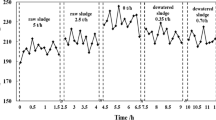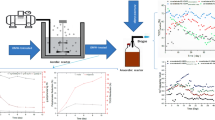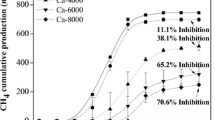Abstract
Experimental study on the influencing factors of using sewage sludge as a denitration agent for cement industry was carried out on a self-made laboratory-scale fluid-bed reactor. Results indicate that sludge combustion at 900 °C shows an ideal NOX (the sum of NO and NO2) removal activity under simulated working conditions of cement precalciner. The optimal removal efficiency of NOX can reach 70.36 ± 3.59% in the presence of cement raw meal (CRM) at a sludge particle size range of 0.18–0.25 mm and the sludge dosage of 0.75 g/min. Besides, the NOX removal efficiency increases to 76.94 ± 5.02% in the absence of CRM, indicating that cement raw meal inhibits the NOX removal. This phenomenon may be attributed to the fact that CRM has promotion effect on NH3 produced and obvious inhibitory effect on CO produced; while NH3 and CO play a leading role in NOX reduction, the combined effect leads to the decrease of NOX removal. Moreover, the relationship between the composition of CRM on the inhibition of NOX removal is MgO < CaCO3 < CRM < Al2O3 <Fe2O3. Meanwhile, the effect of additive variety on the sludge denitration activity indicates that urea significantly promotes the NOX removal, which is attributed to the decomposition of urea to form NH3. The stability experiment shows that sludge denitration efficiency remains stable above 70% in the presence of CRM and can reach over 80% when adding appropriate urea. This method can realize the removal of NOX in the cement kiln flue gas and the resource utilization of sludge. It is a promising method for sludge disposal.








Similar content being viewed by others
References
Benyahia S, Arastoopour H, Knowlton TM, Massah H (2000) Simulation of particles and gas flow behavior in the riser section of a circulating fluidized bed using the kinetic theory approach for the particulate phase. Powder Technol 112:24–33
Bradford M, Grover R, Paul P (2002) Controlling NOx emissions: part 2. Chem Eng Prog 98(4):38–42
Daood SS, Javed MT, Gibbs BM, Nimmo W (2013) NOx control in coal combustion by combining biomass co-firing, oxygen enrichment and SNCR. Fuel 105:283–292
Fang P, Tang ZJ, Huang JH, Cen CP, Tang ZX, Chen XB (2015) Using sewage sludge as a denitration agent and secondary fuel in a cement plant: a case study. Fuel Process Technol 137:1–7
Fang P, Tang ZJ, Xiao X, Huang JH, Chen XB, Zhong PY, Tang ZX, Cen CP (2019) Using sewage sludge as a flue gas denitration agent for the cement industry: factor assessment and feasibility. J Clean Prod 224:292–303
Fu SL, Song Q, Tang JS, Yao Q (2014) Effect of CaO on the selective non-catalytic reduction deNOx process: experimental and kinetic study. Chem Eng J 249:252–259
Georgiopoulou M, Lyberatos G (2018) Life cycle assessment of the use of alternative fuels in cement kilns: a case study. J Environ Manag 216:224–234
Han KH, Niu SL, Lu CM (2010) Experimental study on biomass advanced reburning for nitrogen oxides reduction. Process Saf Environ 88:425–430
Hu Y, Naito S, Kobayashi N, Hasatani M (2000) CO2, NOX and SO2 emissions from the combustion of coal with high oxygen concentration gases. Fuel 79(15):1925–1932
Iliuta I, Dam-Johansen K, Jensen LS (2002) Mathematical modeling of an in-line low-NOX calciner. Chem Eng Sci 57:805–820
Li TJ, Zhuo YQ, Zhao YF, Chen CH, Xu XC (2009) Effect of sulfated CaO on NO reduction by NH3 in the presence of excess oxygen. Energy Fuel 23(4):2025–2030
Li J, Wang S, Zhou L, Luo GH, Wei F (2014) NO reduction by CO over a Fe-based catalyst in FCC regenerator conditions. Chem Eng J 255:126–133
Liu H, Zhang Q, Hu HY, Liu P, Hu XW, Li AJ, Yao H (2015) Catalytic role of conditioner CaO in nitrogen transformation during sewage sludge pyrolysis. P Combust Inst 35(3):2759–2766
Lv G, Lu JD, Cai LQ, Xie XH, Liu ZX (2011) Experimental study on the dynamic process of NO reduction in a precalciner. Ind Eng Chem Res 50:4366–4372
Lv D, Zhu TL, Liu RW, Lv QZ, Sun Y, Wang HM, Liu Y, Zhang F (2016) Effects of co-processing sewage sludge in cement kiln on NOx, NH3 and PAHs emissions. Chemosphere 159:595–601
Ma Y, Wu XD, Zhang JY, Ran R, Weng D (2018) Urea-related reactions and their active site over Cu-SAPO-34: formation of NH3 and conversion of HNCO. Appl Catal B 227:198–208
Neuffer B, Laney M (2007) Alternative control techniques document update: NOX emissions from new cement kilns. Office of Air Quality Planning and Standards, US Environmental Protection Agency
Pavlík Z, Fort J, Zaleska M, Pavlíkova M, Trník A, Medved I, Keppert M, Koutsoukos PG, Cerný R (2016) Energy-efficient thermal treatment of sewage sludge for its application in blended cements. J Clean Prod 112:409–419
Shu Y, Zhang F, Wang H, Zh JW, Tian G, Zhang C, Cui YT, Huang JY (2015) An experimental study of NO reduction by biomass reburning and the characterization of its pyrolysis gases. Fuel 139:321–327
Vadenbo C, Guillen-Gosalbez G, Saner D, Hellweg S (2014) Multi-objective optimization of waste and resource management in industrial networks-part II: model application to the treatment of sewage sludge. Resour Conserv Recycl 89:41–51
Wang DH, Dong N, Niu YQ, Hui SE (2019) A review of urea pyrolysis to produce NH3 used for NOX removal. J Chem Ny 2019:1–11
Xiao X, Fang P, Huang JH, Tang ZJ, Chen XB, Wu HW, Cen CP, Tang ZX (2019) Mechanistic study on NO reduction by sludge reburning in a pilot scale cement precalciner with different CO2 concentrations. RSC Adv 9:22863–22874
Yang XF, Zhao B, Zhuo YQ, Gao Y, Chen CH, Xu XC (2011) DRIFTS study of ammonia activation over CaO and sulfated CaO for NO reduction by NH3. Environ Sci Technol 45(3):1147–1151
Yang JL, Xu WJ, He C, Huang YJ, Zhang ZL, Wang YC, Hu LL, Xia DH, Shu D (2018) One-step synthesis of silicon carbide foams supported hierarchical porous sludge-derived activated carbon as efficient odor gas adsorbent. J Hazard Mater 344:33–41
Zhang H, Fu Y, Tang Z (2011) Catalysis reduction of NO and HCN/NH3 during reburning: a short review. Adv Mater Res 354-355:365–368
Zhang J, Tian Y, Zhu J, Zuo W, Yin LL (2014) Characterization of nitrogen transformation during microwave-induced pyrolysis of sewage sludge. J Anal Appl Pyrol 105:335–341
Funding
This work was supported by the National Natural Science Foundation of China (NSFC-51778264), the Youth Top-notch Talent Special Support Program of Guangdong Province (2016TQ03Z576), the Project of Science and Technology Program of Guangdong Province (2017B020237002 and 2018B020208002), and Outstanding Young Scientific and Technological Talent Support Program of South China Institute of Environmental Sciences.
Author information
Authors and Affiliations
Corresponding author
Additional information
Responsible editor: Philippe Garrigues
Publisher’s note
Springer Nature remains neutral with regard to jurisdictional claims in published maps and institutional affiliations.
Rights and permissions
About this article
Cite this article
Xiao, X., Luo, J., Huang, H. et al. Study on the influencing factors of removal of NOX from cement kiln flue gas by sewage sludge as a denitration agent. Environ Sci Pollut Res 27, 41342–41349 (2020). https://doi.org/10.1007/s11356-020-10126-2
Received:
Accepted:
Published:
Issue Date:
DOI: https://doi.org/10.1007/s11356-020-10126-2




